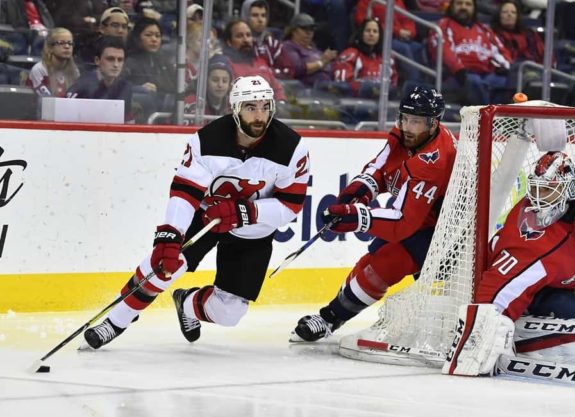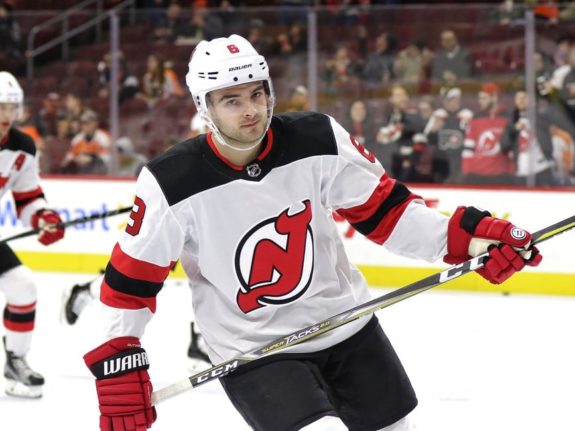![]()
Special teams play a significant role in any NHL team’s success. The New Jersey Devils have one of the best penalty kills in the league. But the same can’t be said for a struggling power play, which has been ice-cold for the last month. With five wins in their last 22 games, their power play is adding to the misery of what is becoming a trying season.
The Devils Aren’t Generating Enough
The Devils’ power play got off to a hot start. They converted on 14 of their first 51 opportunities but are two for their last 35. Despite the strong start, there was cause for concern. The Devils had the 26th-worst Corsi-for per 60 minutes (CF/60) in the NHL over their first 51 opportunities. They also had the ninth-worst expected goals for per 60 minutes (xGF/60).
The Devils were the beneficiaries of Kyle Palmieri’s early-season scoring tear. He had five of their 14 power-play goals and was part of the reason the Devils shot 21.43 percenton the power play. He’s since cooled off, and the Devils’ shot and scoring chance rates have not improved to the level needed.
They have the 13th-best CF/60 over their 2-for-35 stretch, which is an improvement, but they’re still not generating the scoring chances they need to. The Devils are averaging 38.04 scoring chances for per 60 minutes (SCF/60), ranked sixth-worst in the NHL. Their xGF/60 has also dropped from 6.48 to 6.11.

Rick Kowalsky was hired to take over Geoff Ward’s spot as the power-play specialist on Devils head coach John Hynes’ staff. And so far, he has not been able to improve their results. For the season, the Devils have the 25th-best CF/60, 23rd-best xGF/60, and the 29th-best SCF/60. Those numbers aren’t far off where they finished last season when their CF/60, xGF/60, and SCF/60 were 26th, 20th, and 21st respectively in the NHL.
What Else Hampers the Devils’ Power Play?
There are a few reasons the Devils’ power play woes go beyond the stats, some of which boil down to personnel decisions, as well as players who are underperforming. There’s also a noticeable difference in the level of skill between their two units.
The Devils’ first unit consists of Palmieri, Taylor Hall, Marcus Johansson, Nico Hischier, and Will Butcher. That looks pretty good on paper, but Butcher’s struggles are concerning. His scoring rates are down a bit, but it’s his shooting rates that are more of a problem. He has just 10 shots on goal on the power play. If he doesn’t become more of a threat to shoot, opposing teams will continue to have successful penalty kills.
Another issue hurting the Devils is how they deploy their first unit. More often than not, Palmieri and Hall will set up on their strong side. The Devils’ early-season power-play success came when Palmieri was playing in the Ovechkin spot, meaning he set up at the top of the left circle in position for one-timers. They’ve gone back to that in recent games, so the hope is it begins to pay off again.

The Devils’ second power-play unit has also been a problem. They don’t get much production from a unit that sometimes consists of Brian Boyle and Pavel Zacha. Jesper Bratt’s return to the lineup has helped a bit, but they still need more skill on the second unit. That is something they will need to figure out to help get a more productive man advantage.
Related: Devils Schneider on the Schneid
What if the Devils’ Power Play Doesn’t Improve?
There’s a pretty simple answer to this question. It’ll cost them wins, as was the case against the Washington Capitals this past Friday. And while their power play has been terrible, their performance at 5-on-5 has been better. They have the seventh-best 5-on-5 xGF% in the NHL this season, so they’re doing what they need to at full strength.
There is some reason to believe the Devils’ power play can get going, even if the shot and chance rates don’t improve. Their team shooting percentage is 3.7 percent over their last 35 power-play opportunities, ranked worst in the league by a comfortable margin.
The Devils better hope that luck changes soon because at 9-12-5, it’s getting late early in the season. They’ve been good enough at 5-on-5 where if their power play starts scoring, it could give them a significant lift. That may be how they change their season, and what helps them get back in a Metropolitan Division where no one seems ready to pull away.
* * *
Advanced stats from Natural Stat Trick, Corsica Hockey